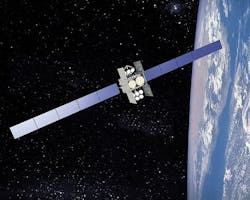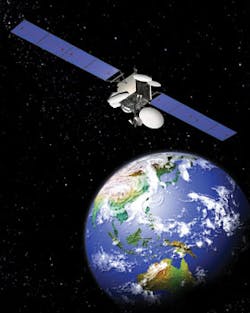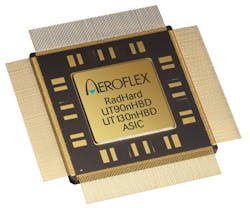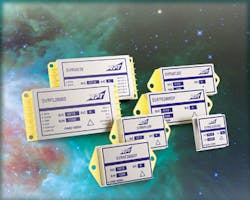Data demands drive robust, rad-hard electronics
Satellites rely on industry advances in high-performance embedded computing and radiation-hardened electronics to capture, process, and distribute intelligence data.
BY Skyler Frink
Space is one of the most difficult environments for electronics, and the systems that contain these electronics must last for years without any maintenance. Unlike aircraft or underwater vehicles, which also enter harsh environments, radiation-hardened electronics often are placed on satellites where, once the system is launched and operating, it will not receive any maintenance at all.
This means radiation-hardened electronics need to be completely fail-proof for their inclusion on systems on which lives often depend. These space systems are becoming more and more common for defense and consumer purposes, from military imaging satellites to consumer communication satellites.
The need for radiation-hardened electronics is growing, and aerospace and defense systems designers are requesting robust, rad-hard equipment capable of fitting systems new and old.
Legacy systems
There are satellites in orbit that have been up for dozens of years; these systems, while functioning, are not expected to last forever. While new systems ideally would replace them, some systems designers are simply looking for products that match legacy systems for form and performance. "Right now, systems designers are not doing a lot of research and development, but they are keeping legacy systems alive," says Peter Milliken, semicustom product manager at Aeroflex Inc. in Colorado Springs, Colo. "They are looking for parts for systems that were designed up to 10 or 15 years ago. The time it takes to requalify systems can take years. In legacy systems, they want form, fit, and function equivalents; which saves months, if not years, and millions of dollars."
With the recent defense budget cuts, keeping legacy systems up and running has been an effective alternative to designing entirely new systems. Many older systems that have begun to fail are being replaced, such as the Landsat remote-sensing satellite. Landsat 8 was launched this year for the sole purpose of keeping the Landsat system from falling into disrepair, and a new launch, Landsat 9, is already being planned to keep the system running beyond Landsat 8's design life.
Designed for data
As with all electronics, superior performance and faster speeds are a primary concern. "The trends in designing have been smaller and better," explains says Simon Wainwright, vice president and general manager of the Microsemi Hi-Rel Group in Lawrence, Mass. "We're seeing more high-speed interfaces. Customers are trying to move a lot more data faster between boxes or between subassemblers in the electronics. If you have video, imagine a satellite taking the picture and having to process and stream that information. Compressing it, managing it, and transmitting it is where the direction is headed." Data processing is so important because of the increasing sensitivity of sensor payloads on satellites.
"The changes have been driven primarily by the sensor," says Aeroflex's Milliken. "We're trying to penetrate to the ground, use radar, take images. The sensor is responsible for collecting a lot of data. What we're seeing over the years is that the sensor's ability to collect more data improves.
"What we end up with is more data that needs to be moved from one satellite to another or back down to the ground, or it needs to be processed by the satellite itself," Milliken explains. "We need more powerful algorithms, more logic, in a smaller space. We are also concerned about power, because a satellite has to generate its power with solar cells. We've got power issues, thermal issues, and a payload that needs to crunch a lot of data and make a decision or send it to the ground. What we have seen is just an increase in the amount of data."
As the volume of data a satellite can gather increases, so too does the necessity of having the processing power to make that raw data useful. Not only is there more to process, but there is a need to process this information while using as little power as possible.
One response to the demand for superior electronics with greater efficiency has been shrinking the size of transistors. "Ninety-nanometer technology is a response to the requirement of more gates per unit area. The 90-nanometer refers to the size of the base transistors; we're building circuits with transistors that are, at a minimum, 90 nanometers," says Aeroflex's Milliken.
"Our systems designers require a particular logic density, and then our systems designers also require specific operating frequency, and they request a certain power. Those things result in physically smaller size transistors," Milliken mentions.
Nintey-nanometer technology may not be new to electronics, but the ability to have transistors of that size and still survive the space environment is. This results in not only superior processing, but also power savings. It does bring up new problems with how the electronics survive radiation, as lower voltages are more susceptible to radiation interference.
"Shrinking tech means you're lowering the voltage," says Milliken, "so the signal-to-noise ratio has gotten worse. The challenge is how do I get smaller and lower voltage and still get the same radiation tolerance."
The challenge of developing electronics that can not only ignore radiation, but also survive in an environment where they are exposed to it is what causes the radiation-hardened market to lag behind other electronics.
New techniques
The radiation-hardened electronics community has been branching out to meet systems designers' demands for efficient and faster computing. One way this has manifested itself is in the industry's consideration of wide-bandgap technologies. Wide bandgap semiconductors feature electronic band gaps that are significantly larger than one electron volt, which gives them an advantage in higher temperature environments as well as higher efficiency. "The wide bandgap technologies provide improvement in terms of switching," explains Microsemi's Wainwright. "They lend themselves to much better efficiencies in, say, power supplies. When you use wide bandgap technologies in converters you can get between 3 and 10 percent increases in efficiencies."
Wide bandgap technologies are not a mature technology for the radiation-hardened industry, where products need to be extremely well tested and reliable to pass muster. "The military tends to be a lot more cautious when it comes to wide band gap technology," says Wainwright. "These technologies are in their infancy at this point and we still have a lot of work to do to say that they're reliable. We feel that they have potential and that we can get there. We just need to do the testing."
Wide bandgap technologies show promise for radiation-hardened electronics, and as the technology matures, it will likely become widespread in the industry with its higher efficiency and possible operating temperature.
Rad-hard market
Space has become more open than ever, with governments and their militaries jumping on the chance to get satellites into orbit. "The space market is definitely growing," says Microsemi's Wainwright. "Every time we turn around, there is a different country going into space. It used to be the U.S. was dominant, and then Europe jumped in; now countries all over the world are getting involved. Everybody wants to put a satellite in orbit."
Not only has space become more accessible, but legacy systems are growing obsolete, and some are even failing. "Satellites are not forever things," says Aeroflex's Milliken. "You have a lot of satellite capacity up there that's aging." Legacy systems are already being replaced, and many companies are looking to maintain the status quo, creating a large market for legacy parts.
These factors have made electronics providers optimistic about the future of the industry, even after the past few years of relatively small growth.



